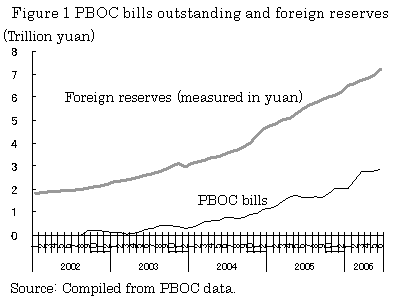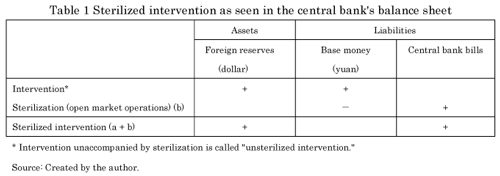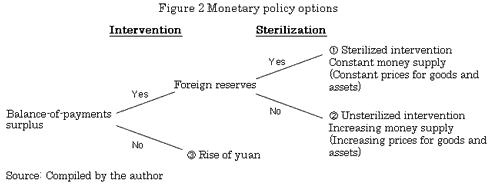The People's Bank of China (PBOC, China's central bank) has continued to intervene in the foreign exchange market at a massive scale, buying as much as $200 billion per year (equivalent to its balance-of-payments surplus) to maintain the yuan's exchange rate against the U.S. dollar. Consequently, China's foreign reserves reached $941.1 billion in June 2006 and are certain to exceed $1 trillion before the end of the year. The resulting excess liquidity has been contributing to the overheating of investment and the expansion of an asset bubble, presenting the central bank with a difficult challenge in steering monetary policy.
Dollar-buying intervention for the purpose of holding down upward pressure on the yuan is nothing other than the PBOC letting out base money (note 1) to the market in exchange for U.S. dollar. Massive intervention of $200 billion per year has been directly boosting the amount of base money by 1.6 trillion yuan ($1 = 8 yuan) a year, which represents an annual increase of approximately 30%. When the money multiplier (note 2) is assumed constant, the broad money supply (M2) is to increase in proportion to the amount of base money.
To prevent excess liquidity and offset the rise in money supply resulting from intervention, a central bank must opt for "sterilization" policy. The most typical method (sterilization in a narrow sense) is to withdraw base money through open market operations: selling of government and/or central bank bills in the market (note 3). The simultaneous conduct of intervention and sterilization (open market operations) is called "sterilized intervention," whereas intervention unaccompanied by sterilization (open market operations) is called "unsterilized intervention."
The interrelation among intervention, sterilization, and sterilized intervention can be confirmed by tracking the changes in the central bank's balance sheet accompanying them (table 1). Intervention increases the amount of dollar-denominated assets (foreign reserves) and base money, a liability item, whereas sterilization (open market operations) reduces base money and instead increases central bank bills (note 4). Sterilized intervention - intervention combined with sterilization - results in an increase in dollar-denominated assets as well as in central bank bills, a liability item. As such, the difference between (unsterilized) intervention and sterilized intervention is what the central bank supplies to the market in exchange for absorbing dollar-denominated assets, namely, highly liquid base money in the former case and central bank bills with low liquidity in the latter.
At this stage, opinions are divided as to whether sterilization in China has been a success as different criteria lead to different evaluations. While base money in June rose 10.0% from the same month last year, increase in CPI remained at a relatively low level, posting a year-on-year increase of 1.0% in July. Judging from this, it may appear sterilization has been successful. At the same time, however, M2 growth accelerated from 14.6% in 2004 to 18.4% in July 2006, reflecting a rise in the money multiplier resulting from the lowering of the cash-deposit ratio as well as of the (excess) reserve-deposit ratio. Against this backdrop, the overheating of investment shows no sign of easing, and property and stock prices are surging. In this sense, it is hard to say that sterilization has been a success.
Furthermore, because intervention is so enormous in scale and has been conducted over a prolonged period, it is becoming increasingly difficulty for the PBOC to implement sterilization operation to keep the money supply under control.
First, in order to make up for the shortage of government securities to sell in open market operations, in April 2003 the PBOC began to issue central bank bills (PBOC bills), the volume of which has been increasing rapidly thereafter. As of June 2006, the amount of PBOC bills outstanding stood at 2.86 trillion yuan, equivalent to 45.4% of base money and up 1.2 trillion yuan from a year earlier (figure 1).
Second, the maturity of PBOC bills is becoming longer; most PBOC bills issued in the initial stage had a maturity of three months, but those with one-year maturity have now come to represent the largest portion. This means that the borrowing cost on the part of PBOC is increasing because the long-term interest rates are higher than the short-term rates.

Third, the yield at issue of PBOC bills is beginning to rise. As of this August 15, the yield at issue of the one-year PBOC bill stood at 2.7961%, up 0.9% from the beginning of the year. The rise in interest rates may trigger a vicious cycle, attracting further capital inflows thereby forcing the central bank to further expand the scale of intervention and sterilization.
Lastly, several times since May this year, the Chinese central bank has issued PBOC bills by means of a "targeted issue" scheme in combination with selling at auction. The targeted issue scheme is to force specific targeted commercial banks to underwrite PBOC bills at a yield lower than prevailing market rates. For instance, on June 14, the PBOC made a targeted issue of one-year maturity bills worth 100 billion yuan at a yield of 2.1138%, 0.4% lower than the then prevailing market rate. Of the PBOC bills issued, 42 billion yuan worth were to be purchased by the China Construction Bank, 30 billion yuan by the Agricultural Bank of China, 12 billion yuan by the Industrial and Commercial Bank of China, 10 billion yuan by the Bank of Communications, and the remaining 6 billion yuan by others. Banks posting a higher increase in lending have a greater chance to be targeted in the scheme. Forced underwriting of PBOC bills at a lower interest rate is operating as a sort of penalty to these banks.
In conducting monetary policy in the presence of enormous balance-of-payments surplus, China is faced with the three choices of (1) sterilized intervention, (2) unsterilized intervention, and (3) allowing the yuan to rise (figure 2). If there are no changes to the foreign exchange policy, China's foreign reserves are expected to increase by more than $200 billion every year, making sterilized intervention even more difficult. With room for further sterilization diminishing, China is being compelled to decide either to let the yuan appreciate at a faster pace while scaling down the intervention, or to accept excess liquidity and the resulting rise in goods and asset prices by continuing the intervention but giving up on sterilization (unsterilized intervention).




